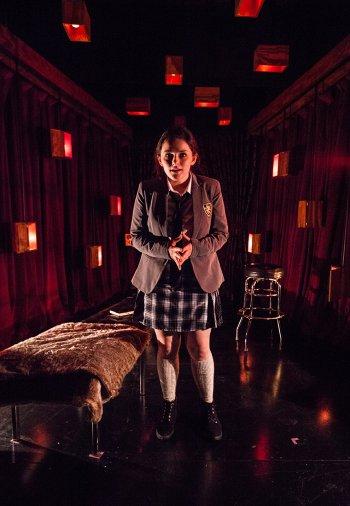The Edge of Our Bodies
Adam Rapp’s latest is a monologue spoken by a 16-year-old prep school girl on her way to New York City: a reading of a short story, not a play.

Carolyn Molloy in a scene from TUTA Theatre’s production of Adam Rapp’s “The Edge of Our Bodies” (Photo credit: Anthony LaPenna)
[avatar user=”Victor Gluck” size=”96″ align=”left” ] Victor Gluck, Editor-in-Chief[/avatar]Although the published script of Adam Rapp’s 2011 The Edge of Our Bodies, now having its New York Premiere courtesy of Chicago’s TUTA Theatre at 59E59 Theaters, states that it take place on the set of Genet’s The Maids at The Blackbox Theater of Whitney Academy, a boarding school somewhere in New England, the audience never guesses until the final moments of the play. That is if they have seen The Maids on stage previously. And don’t wait for that second character to appear as The Maintenance Man only joins the play in its final moments and only has seven, short succinct lines.
Rapp’s plays are so different from each other that it is difficult to classify him. As of now he has written conventional dramas, experimental plays, futuristic and science fiction plays, and dramas on hot button social issues, among others. The Edge of Our Bodies is in yet another form: a monologue spoken by Bernadette, a 16-year-old girl who has left her boarding school on a Friday afternoon without permission to come to New York City to tell her 19-year-old boyfriend Michael that she is pregnant. Carolyn Molloy, who does not at all look 16, reads her story from a diary for much of the play and her delivery is that of a reading, not a dramatic performance.
The blackbox Theater C has been reconfigured to have the audience sit in two rows in a semi-circle on three sides around a playing area wrapped in a see-through black metal mesh. In this area designed by Martin Andrew in which Molloy appears throughout is a bench, a stool and a tape recorder. The lighting by Keith Parham is made up of boxes with bulbs on wires that cast a red light, bringing to mind the title of Rapp’s Pulitzer Prize finalist, Red Light Winter, although the two plays have nothing in common. None of this is explained or is necessary to the play. If this is supposed to be the set of The Maids, how does it reflect on Bernadette’s tale?

Carolyn Molloy in a scene from TUTA Theatre’s production of Adam Rapp’s “The Edge of Our Bodies” (Photo credit: Anthony LaPenna)
Bernadette’s story begins on the New Haven railroad enroute to Grand Central Station. Although the metaphoric title of the play is never explained, it may refer to her closeness to the many men that Bernadette meets along the way on her trip: two businessmen and a grandfather from Stamford on the train, Michael’s father Wayne suffering from cancer living in Brooklyn’s Carroll Gardens, Marc, a married man she picks up in a bar on Greenwich Avenue and with whom she goes to a Holiday Inn, the Maintenance Man (apparently at the school theater) who tells her he has to lock up, a required meeting with Whitney’s Dean Fessenden over her leaving school without permission, her drama teacher Mr. Chubb, and finally the boyfriend Michael for whom she leaves countless messages. While all these people are well drawn, The Edge of Our Bodies has the feeling of a series of vignettes or jottings in a diary, rather than a dramatic whole.
Jacqueline Stone, who also directed the Chicago production in 2016, has allowed Molloy to use the same reading voice throughout which eventually becomes tiresome. Part of the time Bernadette’s story sounds like something remembered in recollection, part of the time she sounds like she is living it at that moment. Which is it? Having told us that she wants to be a short story writer, is this her first completed short story? Rapp’s influences seem to include John Cheever, John Updike and John O’Hara, but The Edge of Our Bodies never rivals those masters. Although this new play by Adam Rapp is never boring, it is also never compelling or fresh.
The Edge of Our Bodies (through April 22, 2018)
TUTA Theatre (Chicago)
59E59Theaters, 59 E. 59 Theaters, in Manhattan
For tickets, call 212-279-4200 or visit http://www.59e59.org
Running time: one hour and 25 minutes with no intermission






Leave a comment